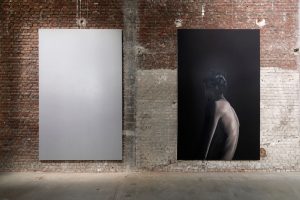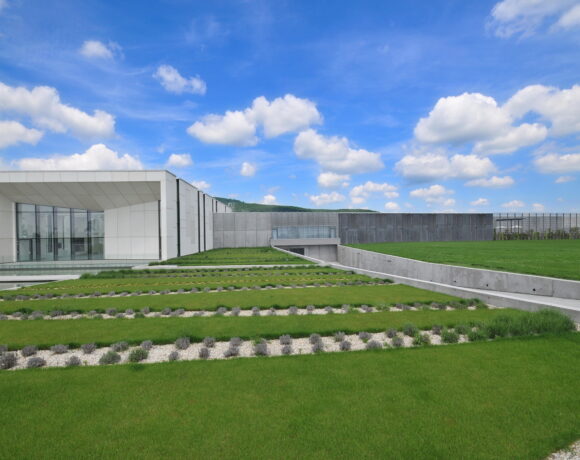The building that houses the Palais de Tokyo was built for the Universal Exhibition in Paris in 1937. From an architectural point of view, the building is truly impressive, of immense proportions, with high colonnades, and a certain severity overall, but with a fascinating scenic brutalism derived from a deliberately unfinished restoration of the interior spaces and which make it very current and close to the spirit of our times. The contemporary art center was founded in 2000 by Nicolas Bourriaud and Jérome Sans (with assignment concluded in 2006), but it should also be added that, under the different directions that gradually followed, the activity has always continued at great quality and expressiveness.
Now, until 24 October 2021 the Palais de Tokyo hosts, in the immensity of all its spaces, “Carte blanche à Anne Imhof, Natures Mortes”, which for this occasion has composed a total and polyphonic work of art, bringing together space and bodies, music and painting, and mixing her works in a flow that welcomes those of about thirty guest artists (in fact, alongside the works of Anne Imhof, we find those of Alvin Baltrop, Mohamed Bourouissa, Eugène Delacroix, Trisha Donnelly, Eliza Douglas, Cyprien Gaillard, Théodore Géricault, David Hammons, Eva Hesse, Mike Kelley, Jutta Koether, Klara Lidén, Joan Mitchell, Oscar Murillo, Eadweard Muybridge, Cady Noland, Precious Okoyomon, Francis Picabia, Giovanni Battista Piranesi, Sigmar Polke, Paul B. Preciado, Bunny Rogers, Sturtevant, Yung Tatu, Paul Thek, Wolfgang Tillmans, Rosemarie Trockel, Cy Twombly, Adrián Villar Rojas). The music is written by Eliza Douglas, while the sound installation is by Eliza Douglas and Anne Imhof. The curatorial project is signed by Emma Lavigne and Vittoria Matarrese.
If it did not sound dangerous, we should speak of a Wagnerian instance that gushes out suddenly and powerful, however, let’s see this instance positively and not for those deleterious aspects that were inappropriately attached to it due to the political disasters of an exalted and warmongering twentieth century. Let us therefore think of the choral nature of the proposal, the plurality of plots, the contrapuntal texture, the rich chromatism, the harmonies, the synthesis of poetic, recitative and visual arts. And we think of all of this as the values of a spectacle that has no equal.
The exhibition path at the Palais de Tokyo therefore invites the visitor to walk the interval between the living and the non-living, between shadow and light, between past and present, between stillness and action, between intensity and disenchantment, and to invent a new perspective of the occupied space. Ultimately it is an uninterrupted song, the one that speaks with the arcane and generates the hidden fragrances: without wanting to be disrespectful I feel like talking about equivalence and correspondence, that is, of forms in alignment, a bit like the planets in harmony of their eye sockets or like the curled up dog that unites the head to the tail.
Anne Imhof (born in 1978 in Giessen, Germany, lives between Berlin and Frankfurt) boasts a very respectable curriculum: we retrace the salient stages. Her first solo show dates back to 2013: “Parade” at the Portikus in Frankfurt; then she arrives at MoMA PS1 (New York, 2015); in 2016 she exhibited at Kunsthalle Basel and Hamburger Banhof (Berlin, 2016); in 2019 she at Tate Modern (London). The author represented Germany at the 57th Venice Biennale in 2017 and on that occasion she won the Golden Lion for best national participation with her performance / installation “Faust” and on that occasion the magazine “Juliet “Dedicated her the cover (n. 183, June 2017). This Parisian stage is, therefore, for the author a further peak reached.
Afterwards, after the conclusion of this complex project by Imhof, Palais de Tokyo will divide its spaces to host a set of exhibitions that we can refer to a distant and mysterious elsewhere of the “hic sunt leones” type, according to ancient cartographic definitions; here is the list: “Ubuntu, un rêve lucide” by Marie-Ann Yemsi; “Sarah Maldoror, Tricontinental” curated by Cédric Fauq & François Piron, with the collaboration of Clément Raveu; “Maxwell Alexandre, Résident SAM 2020”, curated by Hugo Vitrani; “Aïda Bruyère”, curated by Adélaïde Blanc; “Jonathan Jones, sans titre (territoire originel)”, organized by Daria de Beauvais, Alexie Glass-Kantor, Michelle Newton; “Réclamer la terre” (with authors such as: Abbas Akhavan, asinnajaq, Huma Bhabha, Sebastián Calfuqueo Aliste, Megan Cope, Dale Harding, Karrabing Film Collective, Kate Newby, Solange Pessoa, Tabita Rezaire, Thu Van Tran, Judy Watson …), curated by Daria de Beauvais with the scientific support of Léuli Eshrāghi and Ariel Salleh. In short, surprises and news will certainly not be lacking.
Bruno Sain
Info:
Anne Imhof, Carte blanche à Anne Imhof, Natures Mortes
22.05 – 24.10.2021
Palais de Tokyo
13, ave. du Président Wilson, Paris
reservation@palaisdetokyo.com
 Anne Imhof, Untitled (Natures Mortes), 2021, aluminium, acrylic; three panels, 210 × 275 cm (each). Photo credit Aurélien Mole, courtesy of the artist, Galerie Buchholz and Sprüth Magers
Anne Imhof, Untitled (Natures Mortes), 2021, aluminium, acrylic; three panels, 210 × 275 cm (each). Photo credit Aurélien Mole, courtesy of the artist, Galerie Buchholz and Sprüth Magers
 View of the exhibition Carte blanche à Anne Imhof, Natures Mortes, Palais de Tokyo, (22.05.2021 – 24.10.2021). Eléments of Angst opera presented in 2016 at the Kunsthalle of Bâle, at the Hamburger Bahnof of Berlin and in the Biennale de Montréal. Courtesy of the artist and Galerie Buchholz. Anne Imhof, Dive Board (III), 2021, galvanised steel. Courtesy of the artist, Galerie Buchholz and Sprüth Magers. Eliza Douglas, Anne Imhof, Bell, 2021, two-way active speaker, chain. Photo credit Aurélien Mole, courtesy of the artist, Galerie Buchholz and Sprüth Magers
View of the exhibition Carte blanche à Anne Imhof, Natures Mortes, Palais de Tokyo, (22.05.2021 – 24.10.2021). Eléments of Angst opera presented in 2016 at the Kunsthalle of Bâle, at the Hamburger Bahnof of Berlin and in the Biennale de Montréal. Courtesy of the artist and Galerie Buchholz. Anne Imhof, Dive Board (III), 2021, galvanised steel. Courtesy of the artist, Galerie Buchholz and Sprüth Magers. Eliza Douglas, Anne Imhof, Bell, 2021, two-way active speaker, chain. Photo credit Aurélien Mole, courtesy of the artist, Galerie Buchholz and Sprüth Magers
 Anne Imhof, Untitled, 2020, pencil and felt-tip pen on paper, 42 × 29,7 cm. Photo credit Aurélien Mole, courtesy of the artist and Galerie Buchholz
Anne Imhof, Untitled, 2020, pencil and felt-tip pen on paper, 42 × 29,7 cm. Photo credit Aurélien Mole, courtesy of the artist and Galerie Buchholz
 Anne Imhof, Untitled, 2017, oil on canvas, 300 × 190 cm (each). Coll. Pinault Collection (Paris, Venice); photo credit Aurélien Mole, courtesy of the artist and Galerie Buchholz
Anne Imhof, Untitled, 2017, oil on canvas, 300 × 190 cm (each). Coll. Pinault Collection (Paris, Venice); photo credit Aurélien Mole, courtesy of the artist and Galerie Buchholz

is a contemporary art magazine since 1980






NO COMMENT